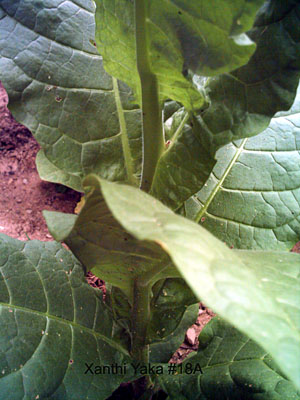http://books.google.com/books?id=UGI4hxx6mTQC
jwinter@unm.edu
"The Akimel O'odham (Pima) of southern Arizona grew both of the domesticated species (N. tabacum and N. rustica) and gathered and sometimes grew three wild taxa (N. attenuata, N. trigonophylla, and N. quardivalvis).
...neighboring Tohono O'odham (Papago) grew the two domesticated species and gathered ...(N. attenuata and N. trigonophylla). The seeds of all four of these species have been reported from prehistoric Hohokam (ancestral Pima) sites in the same region.... N. tabacum and N. rustica and several of the wild species are still used by Native Americans in northern Mexico, so it is clear that the general region was and is a major center of tobacco cultivation and diversity of considerable antiquity. Indeed, it is possible that the diverse species utilized, with their long archaeological record, represent one of the oldest tobacco-growing and tobacco-gathering complexes on the continent, with roots that reach back to well before the arrival of cultivated food plants in the region."
"The Pima Bajo of Sonora, for example, raise N. tabacum and collect N. trigonophylla and N. glauca when the domesticated tobacco is not available in stores or gardens. N. tabacum seeds are sown in small beds or broken ollas, and the seedlings are moved to irrigated plots near the river when the plants are about 20 centimeters (8 inches) high. The Tarahumara in the Sierra Madres of northwest Mexico also raise N. tabacum and N. rustica, and they collect N. glauca and N. trigonophylla. The nearby Warijio (Guarijio) raise both domesticated species, as do the Huichol in the mountains to the south."
"The Tarahumara call all of these tobacco species wipaka, whereas the local mestizos call N. tabacum 'papanti,' N. trigonophylla 'tabaco de coyote' or 'macuchi de coyote,' and N. glauca 'corneton'. ...other Tarahumara names for tobacco are wiuraka and makuchi (N. rustica) and wipanto (N. tabacum)."
[CORNPLANTER]
http://books.google.com/books?id=UGI4hxx6mTQC&pg=PA17&source=gbs_toc_r&cad=4#v=onepage&q&f=false
Tobacco's role in the Haudenosaunee [Iroquois] culture and its value to the families that carry the culture from generation to generation was brought home to me by an Allegany Seneca family descended from Chief Cornplanter, who led the Seneca against the American rebels in the Revolutionary War. In 1994, I visited a number of university herbaria, where I obtained
N. rustica seeds that had been grown from seeds that one of the Cornplanter chiefs had provided in 1915. I was able to grow new plants and then in 1995 to give both the family and the Seneca Tribal Museum in Salamanca New York new seeds, which they now use to produce the sacred tobacco that is so necessary fro their ceremonies.
[Image caption] Cornplanter's tobacco, Nicotiana rustica, grown in 1995 from seeds produced in 1921, which in turn were grown from seeds provided by Seneca Chief Cornplanter in 1915. Height of plant 1.229 m. Photo by Joseph Winter.



















